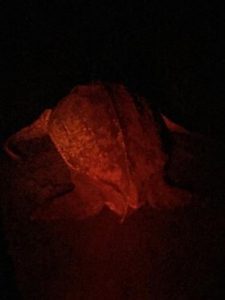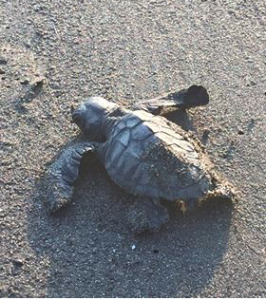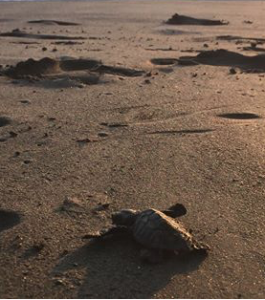Sea Turtle Conservation in Costa Rica

As a senior in my undergraduate career, I had the wonderful opportunity to travel to Ostional, Costa Rica for a once in a lifetime experience. With one of the highest rates of biodiversity in the world, Costa Rica is a fascinating place to visit, especially if you are interested in wildlife. The town of Ostional is internationally recognized for its extensive sea turtle population, and I was very fortunate to spend two weeks at their National Wildlife Refuge. The Olive Ridley turtle (Lepidochelys olivacea) is their most common inhabitant, but Ostional is also home to some Leatherback (Dermochelys coriacea) and Green (Chelonia mydas) sea turtles.
Ostional is a small town located along the coast of the Nicoya Peninsula. The flight into San Jose International Airport and the eight hour bus ride to Ostional were more than worth it. The beaches of Ostional were like nothing I had ever seen before. Watching the sunrise and sunset as it reflected off of the black sand was a wonderful way to begin and end each day. The local people and the staff of the refuge were very welcoming and excited about working with wildlife.

Working on the beach during the day is extremely difficult, so to avoid the blazing sun, volunteers work in the very early morning and the late evenings. The night shifts were my favorite part of my trip to Ostional. During these shifts, we were able to go out with the patrollers to scale the beaches for trespassers and collect measurements on nesting turtles. We were required to wear all dark clothing and a red-shining headlamp in order to not disturb the individuals. Using just moonlight, we were able to see the trackings of the mother turtles coming up from the water; the indentations in the sand from their flippers and plastron were very prominent without an external light source. The trackings were the first sign of a turtle’s presence on the beach, and as we followed, we could start to hear the turtle as she dragged her heavy body to her preferred nesting site.
As soon as a turtle was sighted, we would observe her to determine what stage of the process she was in, or if she was just emerging, we would remain as far as possible until she had decided on a location. Once settled, the nesting turtle will begin securing that spot by tossing sand and making an indent, where she will begin using her back flippers to dig a hole. Soon after, she will begin laying her eggs, and we would use this opportunity to take measurements such as carapace length and width, flipper length, nest depth, and the number of eggs laid. We also tagged the turtle on the front right flipper in the hopes of seeing her again for longitudinal studies. Finally, the mother turtle uses her back flippers to close up the hole, and then she packs the sand by driving her plastron into the sand before heading back to the water.
One night while patrolling the beach, it became very apparent that there was a significant increase in the amount of turtles nesting. The local patroller notified us that this was the sign of an “arribada”, or a large, synchronized nesting time. Sea turtles are usually known for their individual nesting, and this is true for most species of sea turtles. However, the Olive and Kemp’s Ridley turtles are specifically known to have these synchronized nesting times possibly in relation with specific patterns of the moon. The “arribada” was truly a natural wonder as thousands of nesting Olive Ridley turtles emerged from the water over a three day period during both the day and night. It has been estimated that as many as 20,000-60,000 turtles can come to the beach during the dry season, and during the wet season, as many as 90,000-150,000 turtles emerge from the water with the innate drive to lay their eggs in the same place where they hatched. Because of the exuberant amount of turtles looking for space, many turtles will begin to encroach on another’s nest and, unfortunately, many nests from the early hours may be compromised. This problem has been noted by the people of Ostional in the past and, as a result, a legal egg harvesting program was enacted in the 1980’s. This development was a hopeful way to merge economic advancement for the people of Ostional with a scientific venture to theoretically increase the success rate of nestings by increasing sand quality. It was also proposed that this program may also heavily decrease the temptation of poaching specifically on sea turtles that lay their eggs individually. These legal egg collections are only allowed for a specific number of hours after a declared “arribada”, and they are regulated by biologists in studied sections of the beach. Many have viewed the program as a success for both humans and wildlife, but many are also skeptical. Although there have been many longitudinal studies on the economic and scientific implications, this is still an active area of research and ethical conversation for the community.

Seeing thousands of Olive Ridley turtles was an experience in Ostional that I will never forget; however, I also had the additional experience to witness a leatherback sea turtle emerge from the water to lay her nest. Leatherback sea turtles are found periodically nesting on this beach, but they are definitely not as common as the Olive Ridley turtles. When the leatherback was sighted, it was truly a sight to behold, and word of her presence woke up many in the community to come to the beach. Leatherback sea turtles can weigh more than a thousand pounds, and the sound that the turtle made while traveling up the beach demonstrated just how massive she was. In Ostional, I got to learn from a special group of researchers as they collected the data on the less common species: the leatherback and green sea turtle. For this leatherback, the researchers collected her eggs to incubate in a more regulated environment. They do this in the hopes of having a better survival rate and an increase in the Ostional population of the leatherback because they are unfortunately declining. After the eggs hatch, a time is determined to release these newborns on the sand for optimal survival rates. During my stay, I was privileged to see the release of a hatched leatherback nest, and I will never forget the site of these small newborns as they quickly ran towards the open ocean.
Volunteering in Ostional was an extraordinary experience, and I would highly recommend it to anyone interested in wildlife. During my two weeks, I was able to work alongside wonderful local mentors and experience the effect of international wildlife programs. I am eternally grateful to the National Wildlife Refuge and my homestay family for this opportunity; it was surely an experience that shaped my desire to become a zoo and wildlife veterinarian.
If anyone has any questions or would like to talk more about this opportunity, please feel free to email me – vra23@cornell.edu
ABOUT THE AUTHOR:
Victoria Albano is a first year veterinary student from Staten Island, NY. She received her Bachelor of Science from Cornell University in May of 2015, with a major in Animal Science. She is excited about zoo medicine and its impact working in conjunction with conservation education. She hopes to one day work as a zoo or wildlife veterinarian.


